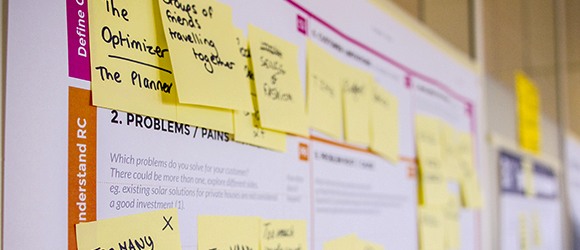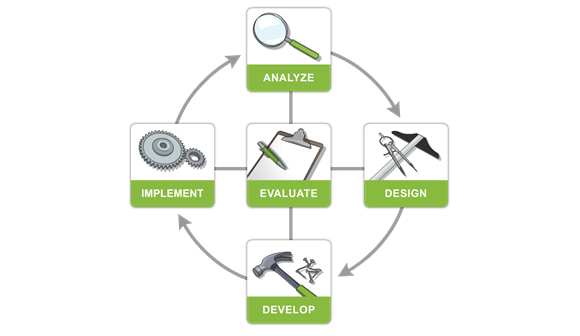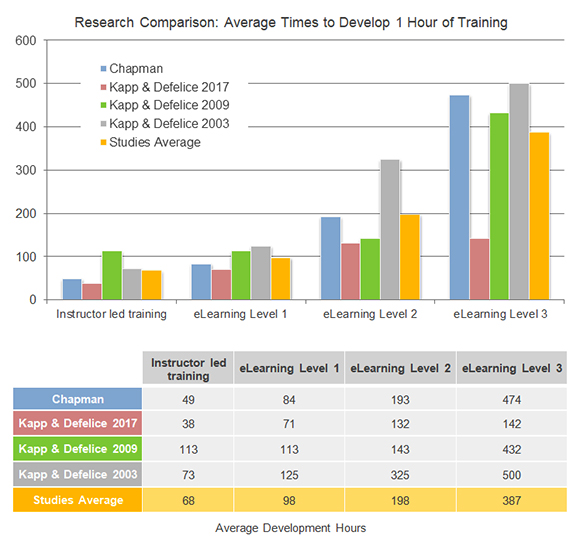How Much Time & Money is Needed to Develop a Training Program?
How much time does it take and how much should it cost to create custom training? Regardless of whether you develop training in-house or you oversee those who do, it's important to be able to determine reasonably accurate estimates of how long it will take to complete a course.

Course design and development costs depend heavily on the instructional design model chosen. And the most widespread and efficient instructional design and development approach is the ADDIE model:

This step-by-step methodology enables you to Analyze, Design, Develop, Implement and Evaluate training programs. Each step of the ADDIE Model involves performing several key tasks to ensure effectiveness of your training program and creating one or more deliverables that result in the final product. In other words, it provides a roadmap for the entire training development process from "What do our people need to learn?" to "Did the learners get what they need?"
Course creation by this model often requires the involvement of these roles:
- Subject matter experts (SMEs): owners of topic or tool expertise, content originators (lecturers, super users, facilitators)
- Instructional design (ID) team: experts at adult learning theory, analysis, course structure and written content creation (instructional designers)
- Media development team: experts with authoring tools and graphics/media production (graphic designers, eLearning course authors, programmers, video production team, illustrators, animators, voice talents)
- Project management team: key point persons who ensure all deliverables support the project's goals and expectations (course owner, project manager)
In this article, we'll talk about estimating the time and cost to develop a training project as it refers to the A-D-D phases of the ADDIE model: Analysis, Design and Development. There are several methods you can use.
Past Projects
Often the best way to jump start the estimation process is to take a look at similar projects you've done in the past. The key is to find elements of your past projects that align with your vision of the new course, such as the delivery method (classroom, webinar or eLearning, etc.), seat time (how long it takes the learners to sit through the full course), the subject matter (software sim, leadership, new hire training, etc.) and who created it (less experience vs. more skilled developers).
Using these elements, review your previous project data for time and budget information. Try looking at data for more than one project, if you can. Going over several past projects and averaging the numbers will give you a better ballpark number to start with. From there, make any necessary adjustments that pertain to varying elements in the new course and you can create a fairly accurate development estimate.
Using Time
What if you don't have any similar past projects or data? One recommendation is to break down the new project into its deliverables (as they pertain to A-D-D) and have the ID and media team members who will perform these tasks estimate their time involved to develop each.
Let's use classroom training as an example. The deliverables for this would likely be a facilitator guide, participant workbook and a PowerPoint slide deck.
First, think about how much time you (or your team) may need to gather, review and analyze any existing materials for the topic. This includes enough time to interview SMEs, create a course outline and incorporate feedback edits.
Now that you have an approved outline, how much time would it take for you to create the facilitator guide? Seat time for the class, complexity of the topic, and the activities to be presented will often determine the number of pages in the guide. Again, be sure to include in your estimate the time required to manage SME input and incorporate edits.
Follow the same process for the participant workbook and PPT. Often the workbook is created from the facilitator guide content, so it normally doesn't take quite as much time to create. And ideally, the PPT has minimal content that's used to support classroom interactions and engagement, so it should be the quickest to put together.
Tack on a percentage of time required to manage the entire project, coordinate team efforts, and launch the training, and you'll have a good ballpark estimate to work from.
Alternatively, another thing you can do is time yourself. It's a simple and accurate way of generating estimates. It's never too late to start keeping track of current projects, so the data can be used in future.
TIP: If scoping training projects is new to you, or if you think development parameters will likely change during the project (for example, creating software training when software is in flux), a good rule of thumb is to include some extra hours to buffer the final estimate. If you find your estimates are off, determine the possible causes and do what you can to scope your next project more accurately.
Refer to Industry Standards
The two most frequently cited research studies on how long it takes to develop one hour of training are from Karl Kapp & Robyn Defelice (2017, 2009, 2003) and Chapman Alliance (2010).
The most recent study by Kapp & Defelice demonstrates the timeframes for producing one hour of basic online learning takes 71 hours on average. The research by Chapman Alliance states that an hour of basic eLearning takes an average of 84 hours to develop and costs a little more than $10,000 to produce. (A basic course has a very low interactivity and media richness level, therefore, more features = more time and money).
To better understand the findings from these studies, average estimate values from each study were calculated and used to create the comparison in the chart below.

Looking at the chart, locate the overall Studies Average number of hours for your new course's proposed delivery method. Sticking with classroom training as our example, 78 is the average number of development hours required to produce a 1-hour ILT course. Use this as the starting number for your project's estimate.
Modify your estimate based on the specific needs and parameters of your project. To do this, consider all of the variables that may affect your course development: complexity of course content, availability of SMEs, experience level of your training production team, course timeline, available budget, etc.
Estimation Variables
To help you further define and estimate your custom training projects, ask yourself the following questions and add to or reduce scope, as appropriate.
| Variable | Questions to Consider |
| Course content and subject matter |
|
| Course design |
|
| Media interface and design |
|
| Template |
|
| Research |
|
| Development tool choices |
|
| Team and timelines |
|
| Subject matter experts |
|
Best Practices to Avoid Scope Creep
- Gain control of the deadline. Have good, solid evidence to support the deadline and stick to it.
- Set very clear expectations for due dates, review times, communication standards and anything else you can think of to make sure that both clients and team members are crystal clear on what you expect of them and what they should expect from you.
- Establish roles and responsibilities for the design and review process. Make sure SMEs are committed to their role and can provide you with timely, thorough, clear feedback. Make sure stakeholders are willing to support you in making this project happen, and communicate that to everyone involved.
Further Research and Tools for Estimating Projects
Bryan Chapman, How Long Does it Take to Create Learning? Chapman Alliance: September 2010
Karl M. Kapp and Robyn A Defelice, Time to Develop One Hour of Training, Updated for 2017 ATD: January 9, 2018
Mary Lorenz, Case Study: Converting an Existing Course to E-Learning 2012
Don Clark, Estimating Costs and Time in Instructional Design June 23, 2010
Don Clark, Excel Spreadsheet Cost Estimator June 23, 2010
Kevin Siegel, eLearning Development Calculator IconLogic: July, 2017



